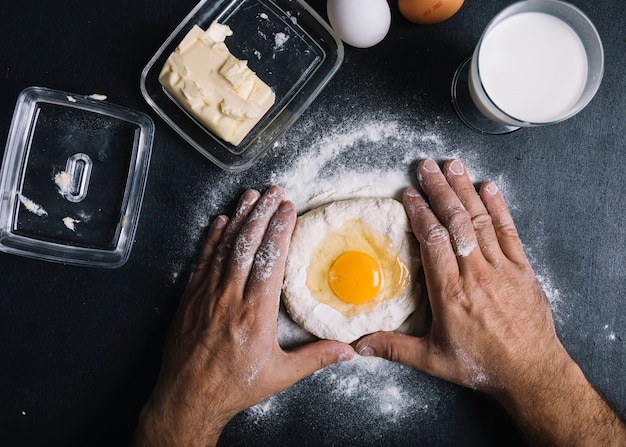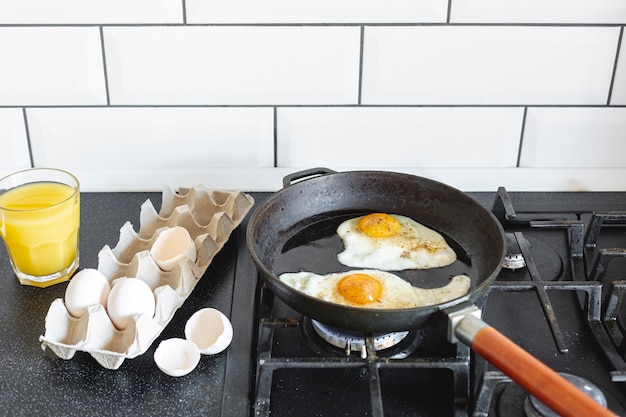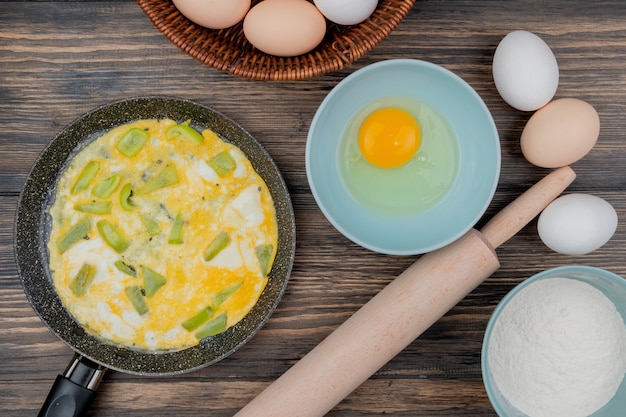Right, let's talk eggs. They're a kitchen staple, a breakfast hero, a culinary chameleon – everyone loves a good egg, right? But let’s face it, cooking a perfect egg can feel like a culinary gamble. You’ve got runny yolks, rubbery whites, and that dreaded green ring around the yolk. It’s enough to make you want to stick with cereal, isn't it?
Fear not, my fellow egg enthusiasts! Over the years, I've learned a thing or two about eggs, and I'm about to share all my secrets with you in this comprehensive guide. We'll delve into everything from choosing the right eggs to mastering different cooking methods, and even tackling some common egg-cooking mishaps. I'll even throw in some tips and tricks I've picked up along the way.
So grab your apron, crack open an egg, and let's get cooking!
(Part 1) Egg-cellent Essentials: Choosing the Right Eggs

The Egg-sploration Begins: Understanding Egg Types
Before we even think about cooking, let’s talk eggs themselves. You've got your standard brown and white eggs, but there are also free-range, organic, and even coloured eggs. Knowing the differences is key to choosing the right egg for your dish.
Personally, I prefer free-range eggs. They're not only a bit tastier, but also kinder to the hens. They've had access to the great outdoors, which means they've been able to roam around and eat a more natural diet. This translates to richer yolks, a slightly creamier texture, and often a more pronounced flavour. However, it all boils down to personal preference and budget.
The Great Egg Debate: Brown vs. White
Now, let’s address that age-old question: Brown or white eggs? Do they actually taste different? The truth is, the colour of the shell doesn't actually affect the flavour or nutritional value. It simply depends on the breed of hen. Brown eggs are usually laid by Rhode Island Red hens, while white eggs are laid by White Leghorn hens. So, next time you're at the supermarket, choose the colour that appeals to you, because they're essentially the same!
Beyond the Basics: Exploring Specialty Eggs
If you're feeling adventurous, there's a whole world of specialty eggs out there, waiting to be explored! For example, you can find duck eggs, quail eggs, and even coloured eggs in different shades of blue, green, and brown. These eggs offer unique flavours and textures, and they're a great way to add a touch of excitement to your cooking.
Duck eggs have a richer, slightly gamier flavour than chicken eggs, and they're great for baking cakes or making omelettes. Quail eggs are smaller and have a more delicate flavour. They’re often used as a garnish or in salads. And then there are the coloured eggs, which are simply a result of different breeds of hens. They’re a fun addition to any breakfast or brunch.
(Part 2) The Art of Egg Preparation: Prepping for Success

Egg-ceptional Storage: Keeping Eggs Fresh
Now that you've chosen your eggs, it's time to store them properly. The fridge is your best friend here. Keep those eggs in their original carton and store them on a shelf, not in the door. The door fluctuates in temperature, which can affect the freshness of your eggs.
Why is freshness important? Well, as eggs age, the air sac inside gets larger, making the egg less dense. This can affect the texture of your cooked eggs, making them more prone to becoming rubbery.
The Egg-cellent Cracking: A Gentle Approach
Cracking an egg can be tricky, but with a bit of practice, it becomes second nature. The key is to be gentle. Crack the egg on a flat surface, like the countertop, and gently separate the halves. This helps prevent the shell from breaking into tiny pieces that can end up in your food.
I always find it helpful to crack the egg on the edge of the bowl, rather than directly on the bottom. This helps control the direction of the crack and reduces the chance of shell fragments falling in.
Egg-ceptional Separation: The White Knight
Separating egg whites from yolks is a common task in baking and cooking. The simplest way is to crack the egg into a bowl and carefully pour the white into another bowl, leaving the yolk in the first bowl.
However, there's also a clever trick using an empty bottle. Hold the bottle over the yolk and gently squeeze the bottle, creating a vacuum that sucks the yolk into the bottle. This method is particularly useful when you need to separate a large quantity of eggs.
(Part 3) The boiled egg: A Classic with a Twist

Boiling Basics: A Simple Yet Crucial Skill
boiled eggs are a staple in many households, but getting them just right can be a bit of a challenge. The key is to cook them gently and for the right amount of time. A good rule of thumb is to bring a pot of water to a rolling boil, then gently lower the eggs into the water. This prevents the eggs from cracking due to the sudden change in temperature.
Egg-cellent Timing: Mastering the Perfect Boil
The cooking time for boiled eggs depends on how you want them. Here's a handy table for your reference:
| Cooking Time | Result |
|---|---|
| 3 minutes | Soft boiled with a runny yolk |
| 5 minutes | Medium boiled with a soft yolk |
| 7 minutes | Hard boiled with a slightly soft yolk |
| 8 minutes | Hard boiled with a firm yolk |
For soft boiled eggs, you can even try the "spoon test." Gently tap the egg against the side of the pan. If the egg makes a hollow sound, it's ready.
Egg-ceptional Cooling: Preventing That Green Ring
After cooking, immediately transfer the eggs into a bowl of ice water to stop the cooking process and prevent that dreaded green ring around the yolk. This happens because the iron in the yolk reacts with the sulfur in the white, causing a chemical reaction that results in the greenish hue.
(Part 4) The Fried Egg: A Culinary Masterpiece
Frying Fundamentals: Choosing the Right Pan
The pan you choose is essential for frying eggs. cast iron pans are excellent for even heat distribution, and they add a lovely crispness to the whites. non-stick pans are also a good choice, especially for beginners, as they require less oil and make flipping easier.
Egg-ceptional Heat: A Moderate Approach
Avoid high heat when frying eggs, as this can lead to burnt whites and a rubbery texture. Medium heat is perfect for achieving a crispy white and a runny yolk.
Egg-cellent Technique: The Flip or No Flip Debate
The art of flipping an egg is a debate that has divided chefs for centuries. Some prefer to flip, achieving a perfectly cooked yolk and a crispy white on both sides. Others leave the yolk runny, creating a luxurious, runny centre. Ultimately, it's up to your personal preference.
If you choose to flip, use a spatula to gently lift the egg from the pan. It's best to flip the egg when the white is set, but the yolk is still runny.
Egg-ceptional Variations: Adding Flavour and Fun
You can spice things up with fried eggs by adding toppings like cheese, herbs, or even crispy bacon. You can also get creative with shapes and patterns. Use a cookie cutter to create a heart-shaped fried egg for a romantic breakfast, or a star-shaped egg for a fun children's meal.
(Part 5) The Scrambled Egg: A Breakfast Classic
Scrambled Secrets: The Art of Smoothness
scrambled eggs are a comforting classic, but the key is to achieve a smooth and creamy texture. You can achieve this by whisking the eggs with a splash of milk or cream before cooking. This adds moisture and helps create a smoother consistency.
Egg-cellent Cooking: Avoiding Rubberiness
Overcooked scrambled eggs can be dry and rubbery. To avoid this, cook them over low heat and stir constantly. You want to cook them just until they're set, not dry.
A good indicator is when the eggs start to set on the edges of the pan. At this point, the mixture should be creamy and still slightly wet.
Egg-ceptional Flavour: Adding a Touch of Magic
Spice up your scrambled eggs with herbs, cheese, or even vegetables. You can even add a splash of soy sauce or sriracha for a touch of Asian flair.
(Part 6) The Omelet: A Culinary Canvas
Omelet Mastery: Building a Foundation
Omelets are a great way to showcase your culinary creativity. The key is to create a thin, smooth base. You can achieve this by whisking the eggs with a little milk or cream and cooking them over medium heat.
Once the eggs start to set, tilt the pan and let the uncooked egg run underneath. This helps create a thin and evenly cooked base.
Egg-cellent Folding: The Art of the Omelet
Once the base is cooked, carefully fold the omelet in half or thirds, depending on your preference. You can use a spatula to help you fold the omelet, ensuring even cooking.
For a classic French omelet, the goal is to create a smooth, thin omelet with a soft, slightly runny centre. A more American omelet tends to be thicker, with more fillings.
Egg-ceptional Fillings: The Culinary Limitless
Omelets are a blank canvas for your culinary creativity. You can add cheese, herbs, vegetables, and even leftover meats to create a delicious and satisfying meal.
Some popular omelet fillings include: cheese, mushrooms, spinach, ham, bacon, and tomatoes.
(Part 7) The poached egg: The Ultimate Gourmet Indulgence
Poaching Perfection: The Gentle Art of Egg Cooking
poached eggs are a culinary delight. The trick is to gently poach the egg in simmering water until the white sets and the yolk remains runny.
Egg-cellent Technique: Achieving that Perfect Poach
Add a splash of vinegar to the poaching water to help the egg white coagulate and form a neat shape. Carefully crack the egg into a small bowl and gently slide it into the simmering water. Cook for 3-4 minutes, or until the white is set and the yolk is still runny.
You can also use a poaching ring, which helps keep the egg in a neat shape.
Egg-ceptional Presentation: Serving with Style
Poached eggs are best served on a bed of greens or toasted bread. You can also add a touch of hollandaise sauce for a luxurious touch.
(Part 8) The Deviled Egg: A Party Favourite
Deviled Egg Delight: A Classic with a Twist
deviled eggs are a classic party appetizer. The key is to create a creamy and flavorful filling.
Egg-cellent Preparation: From Hard Boiled to Deviled
Hard boil the eggs and carefully remove the yolks. Mash the yolks with mayonnaise, mustard, and seasoning. You can use a fork or a potato masher to get a smooth consistency.
Egg-ceptional Variations: Embracing Culinary Creativity
Deviled eggs can be dressed up with various toppings and fillings. Add chopped chives, paprika, bacon bits, or even a dollop of sour cream.
You can also experiment with different flavour combinations, such as adding a pinch of cayenne pepper for a spicy kick, or a dash of smoked paprika for a smoky flavour.
(Part 9) Egg-cellent Troubleshooting: Fixing Common Mistakes
Egg-cellent Recovery: Fixing Runny Whites
If you've overcooked your eggs and the yolks are runny, don't despair. Simply add a bit more heat to set the whites. You can also add a tablespoon of water to the pan and cover it with a lid for a minute or two. This creates steam that will help cook the whites without overcooking the yolks.
Egg-cellent Recovery: Fixing Rubber Whites
If you've overcooked your eggs and the whites are rubbery, there's not much you can do. However, you can try to salvage the situation by adding a little bit of milk or cream to the pan and cooking the eggs for a few more minutes. This will help add moisture and soften the rubbery whites.
Egg-cellent Recovery: Fixing the Green Ring
If you have a green ring around the yolk of your boiled eggs, it's a sign that the eggs have been cooked too long. This happens because the iron in the yolk reacts with the sulfur in the white.
While the green ring is harmless, it can be unsightly. To prevent it, make sure to cool the eggs in ice water immediately after cooking.
(Part 10) The Egg-ceptional FAQs: Your Questions Answered
1. Why do my eggs smell bad?
Eggs that smell bad are usually spoiled. This is due to the growth of bacteria. Discard any eggs that have a foul odour.
2. How can I tell if my eggs are fresh?
There are a few ways to tell if an egg is fresh. First, check the date on the carton. Second, hold the egg up to your ear and gently shake it. A fresh egg will make a faint sound, while a stale egg will make a more pronounced sound.
You can also use a bowl of cold water to check the freshness of an egg. A fresh egg will sink to the bottom and lie flat. A stale egg will float, as the air sac inside has expanded with age.
3. What are the health benefits of eggs?
Eggs are an excellent source of protein, vitamins, and minerals. They are also a good source of choline, which is important for brain health, memory, and muscle function.
Eggs are low in calories and a great source of vitamins B12, D, and E, as well as minerals like selenium and zinc.
4. Can I freeze eggs?
Eggs can be frozen, but they're best frozen in their raw form, not cooked. To freeze raw eggs, simply crack them into a container and whisk them together with a little salt or sugar to prevent them from separating.
Frozen eggs are best used in baking, as they tend to have a slightly different texture when cooked.
5. Can I eat raw eggs?
While some people enjoy raw eggs in dishes like Caesar salad dressing, it's important to note that raw eggs can carry salmonella bacteria. If you're pregnant or have a weakened immune system, it's best to avoid eating raw eggs altogether.
If you do choose to eat raw eggs, make sure they are from a reputable source and are handled properly.
Now you’re ready to conquer the world of egg cooking. Remember, practice makes perfect, so don’t be afraid to experiment and find what works best for you. And most importantly, enjoy the journey of discovering your egg-cellent cooking skills!
Everyone is watching

Prime Rib Roast Cooking Time Chart: Per Pound Guide
Cooking TipsPrime rib roast. Just the name conjures images of lavish dinners, crackling fires, and hearty laughter. It’s ...

How Long to Bake Potatoes in the Oven (Perfect Every Time)
Cooking TipsBaked potatoes are a staple in my kitchen. They're incredibly versatile, delicious, and surprisingly easy to m...

Perfect Rice Every Time: The Ultimate Guide to Cooking Rice
Cooking TipsAs a self-proclaimed foodie, I've always been a bit obsessed with rice. It's the foundation of countless cuisi...

The Ultimate Guide to Cooking Asparagus: Tips, Techniques, and Recipes
Cooking TipsAsparagus. The mere mention of this spring delicacy conjures up images of vibrant green spears, crisp and burs...

Ultimate Guide to Cooking the Perfect Thanksgiving Turkey
Cooking TipsThanksgiving. Just the word conjures up images of overflowing tables laden with delicious food, the scent of r...
